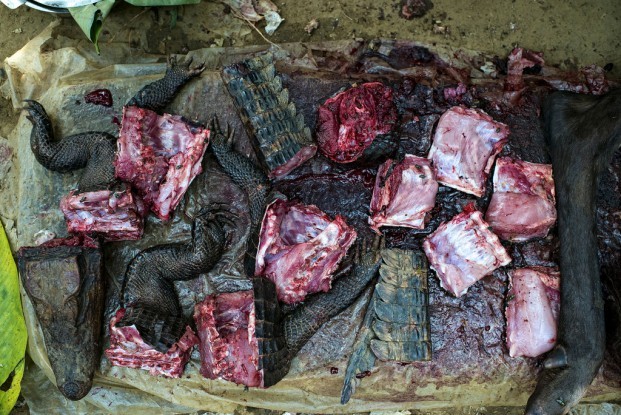
HYDERABAD, India (30 October, 2012)_The first step to managing bushmeat and other non-timber products taken from the Congo Basin forest is to understand the market, a scientist said, noting that while this informal, often illegal trade accounts for up to 80 percent of household incomes, data is still needed in order to make informed decisions.
Robert Nasi, a scientist with the the Center for International Forestry Research, made the comments during a presentation at an Observatoire des Forêts d’Afrique Centrale side event at the 11th Conference of the Parties on the Convention on Biological Diversity in Hyderabad, India.
He focused largely on bushmeat.
The Congo Basin forest spans 1.6 million square kilometres and is home to 75 million people — making it nearly half the size of the Amazon with four times the population density, he noted. And research shows, the 4.5 million tonnes of the wild game consumed annually by those living in and around the forest can account for more than three-quarters of all protein intake.
Many believe the only solution is to find sustainable ways to manage the harvest and trade. But with a very limited understanding about the market, that’s nearly impossible.
“If you don’t know the resource and the demand, you cannot manage it,” said Nasi, who is also the director of the CGIAR Program on Forests, Trees and Agroforestry.
And bushmeat is not the exception.
The same can be said for all non-timber forest products (NTFP) — which can include anything from nuts, fruits and mushrooms to barks, charcoal and fuel wood.
In addition to subsistence use, these products represent 17 percent to 67 percent of all trade in the Congo Basin.
To get an idea about how vast the market is, one need only consider this: The capital city on the Democratic Republic of Congo, Kinshasa, consumes 4.5 million cubic metres of wood for cooking purposes: an amount that dwarfs national official timber production (less than 400,000 cubic metres in 2010)
So what are some of the issues?
For one, Nasi said “it is very difficult to manage products that move and/or don’t belong to anyone, such as wildlife, fruits or barks.”
Another issue lies in the NTFP value chains themselves. Currently trade of these products is widespread but as most of it is informal or illegal it doesn’t enter national accounting systems and hence is largely overlooked.
It’s a “free-for-all,” said Nasi.
“A classic example of the tragedy of the commons.”
“There is bad governance, the influence of the elites and corruption, as well as the lack of motivation of many players to do something about it.”
So what are the solutions?
Nasi says the first step is to define the stakeholders in the NTFP value chains, including those creating a large demand for the products outside the forest areas. Scientific methods need to be employed to quantify the amount of non-timber products being used.
“Right now we don’t know how to measure sustainable harvesting of rattan or hunting for bush meat,” Nasi said.
It’s important, too, to recognise that a ban on these products is not an option.
“If you ban or stop the use of these products, you create a problem for livelihoods, particularly for women,” said Nasi referring to the high proportion of women and children involved in the trade in non-timber products.
“If NTFPs get scarce, it means more time away from the house collecting and gathering and less time looking after household.”
Women especially need to be considered in the debate about bushmeat policy because they tend to re-invest money back into their households.
Their husbands, on the other hand, “often invest in non-essential goods”.
Roland Melisch, Director of TRAFFIC’s Africa & Europe programmes, was presenting at the same meeting,
He reminded the audience that bushmeat can be anything from primates to terrestrial vertebrates like turtles, snakes, birds and medium sized mammals.
“Bushmeat harvest and trade is considered a crisis among those in the Western Hemisphere,” he said noting that they often look only at chimpanzees, gorillas and bonobos.
“But these are not the only fauna “used” or consumed,” he said, adding that this protein source was particularly important to rural populations.
“For farmers who don’t raise cattle and chicken, [eating and participating in the bushmeat trade] this is about survival.”
CIFOR’s research and recommendations on the sustainable management of bushmeat were recently submitted by an advisory body that assesses the status of biodiversity around the world and then accepted by the Convention of Biological Diversity (CBD) as part of the CBD’s mandate to improve sustainable use of biodiversity in a landscape perspective.
The recommendations will provide guidance to policy makers, NGOs, and practitioners working in conservation and development on how to sustainably manage bush meat resources.
We want you to share Forests News content, which is licensed under Creative Commons Attribution-NonCommercial-ShareAlike 4.0 International (CC BY-NC-SA 4.0). This means you are free to redistribute our material for non-commercial purposes. All we ask is that you give Forests News appropriate credit and link to the original Forests News content, indicate if changes were made, and distribute your contributions under the same Creative Commons license. You must notify Forests News if you repost, reprint or reuse our materials by contacting forestsnews@cifor-icraf.org.